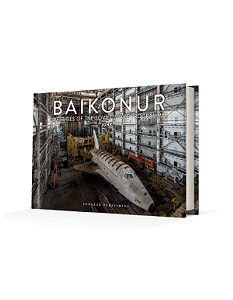Places are important to human beings and places where great events of space history have occurred are especially important to members of the space community. Many of the names evoke images of the events that took place there: Canaveral, Kourou, Shriharikota, Woomera... choose your favourite.
The Baikonur Cosmodrome is among the most notable, not least because it launched the world’s first satellite and first manned spacecraft. It is also one of the least well understood, thanks to decades of Cold War obfuscation and years of neglect following the dissolution of the Soviet Union. To be frank, even a visit to a launch pad and museum at the Cosmodrome does little to put the huge tracts of nothingness into perspective, which is where this book comes into its own.
From the publisher of the wide-ranging ‘Secret…’ guides and ‘Abandoned…’ places series, this photo book on Baikonur fits well into the Abandoned genre. More of an art book than a technical description of the place, it is unlikely to do much for Baikonur’s marketing department (assuming that concept is not too much of a stretch); instead, it celebrates the stark reality of abandoned technology and the abstract beauty of peeling paint. In that sense, it does what it says in its sub-title by recording the “vestiges of the Soviet space programme”.
Before the photographer, ‘Jonk’, gets to the images, he writes a potted history of the programme, illustrated by some of the colourful graphic and politically-informed art that ‘marketed’ the programme to the Soviet populace and the world. He continues with a diary of his trip to Kazakhstan, and the Cosmodrome itself, which is sometimes pedestrian, sometimes innocent… and then you realise it is a users’ guide on how to break into a foreign launch site without getting noticed! Three days of self-sufficiency, walking more than 40 km, carrying food and water and sleeping in abandoned spacecraft facilities followed a night-time car ride to the target area that cost “several months’ local earnings”. The main objective of the intrepid and anonymous crew was to get inside the abandoned Buran shuttle and Energia rocket hangars.
The text gives the impression of an amateur jaunt, but this is urban exploration at its most serious: walkie-talkies, night-vision goggles and 20 kg of photographic equipment; a rota for lookout duty, hiding from security patrols in metal cabinets and standing very still for long moments to avoid the echoing sound of breaking glass shards.
The resulting photos are excellent and, as one expects from this publisher, the book is very well-produced. As a space technologist, amateur historian and part-time stock photographer, am I envious of the results? You bet I am… but I’m fairly sure I wouldn’t be willing to go through what Jonk and his urbex ninjas did to get those images!











